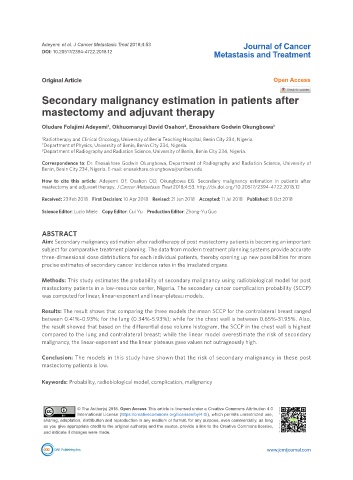Page 630 - Read Online
P. 630
Adeyemi et al. J Cancer Metastasis Treat 2018;4:53 Journal of Cancer
DOI: 10.20517/2394-4722.2018.12 Metastasis and Treatment
Original Article Open Access
Secondary malignancy estimation in patients after
mastectomy and adjuvant therapy
Oludare Folajimi Adeyemi , Okhuomaruyi David Osahon , Enosakhare Godwin Okungbowa 3
2
1
1 Radiotherapy and Clinical Oncology, University of Benin Teaching Hospital, Benin City 234, Nigeria.
2 Department of Physics, University of Benin, Benin City 234, Nigeria.
3 Department of Radiography and Radiation Science, University of Benin, Benin City 234, Nigeria.
Correspondence to: Dr. Enosakhare Godwin Okungbowa, Department of Radiography and Radiation Science, University of
Benin, Benin City 234, Nigeria. E-mail: enosakhare.okungbowa@uniben.edu
How to cite this article: Adeyemi OF, Osahon OD, Okungbowa EG. Secondary malignancy estimation in patients after
mastectomy and adjuvant therapy. J Cancer Metastasis Treat 2018;4:53. http://dx.doi.org/10.20517/2394-4722.2018.12
Received: 23 Feb 2018 First Decision: 10 Apr 2018 Revised: 21 Jun 2018 Accepted: 11 Jul 2018 Published: 8 Oct 2018
Science Editor: Lucio Miele Copy Editor: Cui Yu Production Editor: Zhong-Yu Guo
ABSTRACT
Aim: Secondary malignancy estimation after radiotherapy of post mastectomy patients is becoming an important
subject for comparative treatment planning. The data from modern treatment planning systems provide accurate
three-dimensional dose distributions for each individual patients, thereby opening up new possibilities for more
precise estimates of secondary cancer incidence rates in the irradiated organs.
Methods: This study estimates the probability of secondary malignancy using radiobiological model for post
mastectomy patients in a low-resource center, Nigeria. The secondary cancer complication probability (SCCP)
was computed for linear, linear-exponent and linear-plateau models.
Results: The result shows that comparing the three models the mean SCCP for the contralateral breast ranged
between 0.41%-0.93%; for the lung (0.34%-5.93%); while for the chest wall is between 0.65%-31.95%. Also,
the result showed that based on the differential dose volume histogram, the SCCP in the chest wall is highest
compared to the lung and contralateral breast; while the linear model overestimate the risk of secondary
malignancy, the linear-exponent and the linear plateaus gave values not outrageously high.
Conclusion: The models in this study have shown that the risk of secondary malignancy in these post
mastectomy patients is low.
Keywords: Probability, radiobiological model, complication, malignancy
© The Author(s) 2018. Open Access This article is licensed under a Creative Commons Attribution 4.0
International License (https://creativecommons.org/licenses/by/4.0/), which permits unrestricted use,
sharing, adaptation, distribution and reproduction in any medium or format, for any purpose, even commercially, as long
as you give appropriate credit to the original author(s) and the source, provide a link to the Creative Commons license,
and indicate if changes were made.
www.jcmtjournal.com

